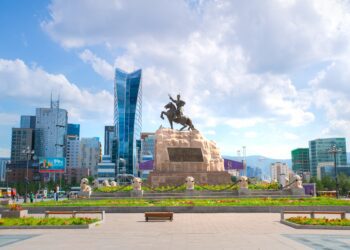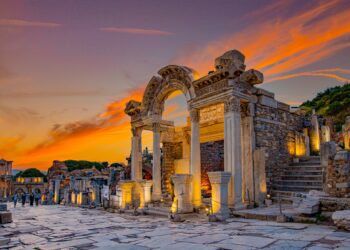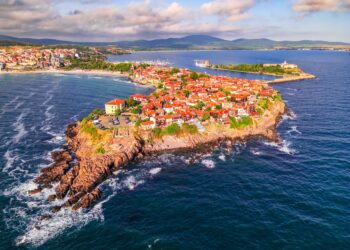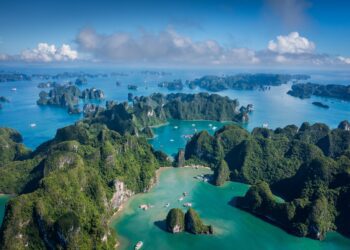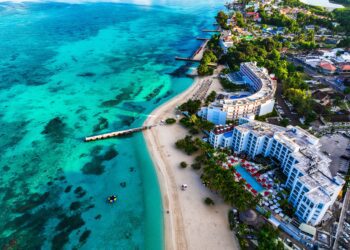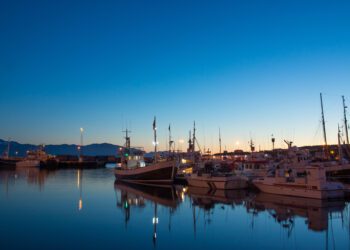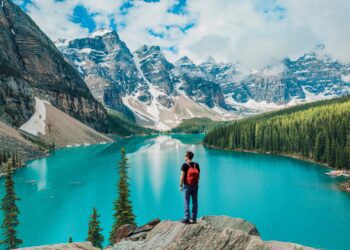On the lamp-lit steps of a sombre gothic church, a young woman stands before a microphone. Beside her, a man plucks a slow melody from his guitar. Arrayed on chairs and cobblestones in front of them, a large crowd sits in an expectant silence. From a nearby balcony, laundry sways in the sultry Calabrian breeze.
“Sustarìa is a word in the dialect of Lago,” says Cristina Muto, who co-founded the festival in summer 2020. “It is a creative restlessness, which doesn’t let you sit still.” We’re speaking at a drinks party the evening before the annual event, on a terrace overlooking Lago’s clay-tiled roofs, when her brother Daniele appears with a jug of local wine in hand. “Welcome to Lagos Angeles, Calabrifornia,” he winks, pouring me a cup.
Lago is a hilltop village in the province of Cosenza, overlooking the Mediterranean. It’s surrounded by sprawling olive groves and small plots where families cultivate figs, chestnuts and local grains. Cristina and Daniele were born and raised in this grey-stoned hamlet, a medieval outpost of the Kingdom of the Lombards. Although their pride in Lago is palpable, few of the Laghitani I meet live here all year round. Like many young people from southern Italy, they have left in search of opportunities that are scarce in Calabria.
It’s against this backdrop that Cristina co-founded Sustarìa. “The trend is longstanding and severe,” she tells me, “but people still live here, and there are communities that thrive despite the problems. If more people stay or return, things will get better.” By spotlighting the allure of the region’s heritage, she hopes to play a part in this.
With agriculture historically shaping Calabria’s economy and its inhabitants’ daily lives, many traditions have agrarian roots. The dance that erupted on the festival’s first night was the tarantella. It features distinctive footwork, with dancers kicking their heels rapidly. “It’s a dance of the field workers,” Cristina says. “Some say it began as a way to sweat out venom from spider bites during harvests; others say tired workers in need of a creative outlet danced slowly and just with their feet, and over time the pace and range of movement increased.”
The vocals on display that night told of another aspect of the region’s history: its frequent colonisation. Calabria was variously conquered by Greeks, Romans, Byzantines, Normans, Arabs, Lombards and Bourbons. The folk songs we heard were replete with Greek scales and Arabic cadences, a melting pot of Mediterranean timbres.
After the concert, the crowd migrated to a field by a small waterfall on the outskirts of Lago for dinner featuring regional dishes: rosamarina (the pescatarian version of nduja, known as “Calabrian caviar” made from tiny fish); fried courgette flowers; cipolla rossa di Tropea (red onions from the popular beachtown of Tropea); and pecorino crotonese, a sheep’s cheese from the Crotone province.
At Palazzo Rossi, on the edge of town, we take a seat at a cafe and sip local craft beer as we admire the view of the active volcano Mount Stromboli, across the water.
“You should see it in the winter,” Cristina says. “The air is cooler, so it becomes even clearer. Everything here is completely different in the winter, but most people don’t see it as visitors come mainly in the summer,” she adds with a note of regret.
The sun starts to sink into the horizon. In the square, a band starts setting up for an evening gig. A waiter brings over a plate of bread and olives to our table, on the house. “Things are quieter but not empty. There are almost as many events as in summer. And you get to see how the locals live during the rest of the year.” Cristina tears off a piece of bread. “And, of course, the hospitality never changes – people are always welcomed with open arms.”





